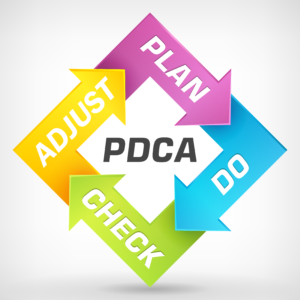Change Management Lesson 6: Reinforcement helps new habits stick
Feb 25, 2020

What is the biggest barrier to change in an organization?
Many people will say managing resistance among employees. That is an important topic, but I think it is over-emphasized. Resistance among employees is more often a symptom of not planning to manage your change rather than an indicator of a problematic employee. In other words, if your employees are not engaged in promoting and sustaining the change, the most likely culprit is that the organization did not think carefully about creating awareness of why the change is needed, desire for meeting the challenge as a team, knowledge to be able to operate in the new mode and ability to successfully complete the new tasks.
The biggest challenge to sustaining change arguably isn't employee resistance – it's habit. Truly resistant employees are rare, but every human being is subject to the power of habit. We can all benefit from some help to avoid falling back into old habits and sustain the initial momentum and excitement of the improved way of getting the work done.
Another obstacle to sustained change is that many organizations structure change as explosions of effort more often than the simmer of energy that creates a change that sticks. Even if you did do a great job setting up the need for change and providing opportunities to learn and grow in a safe environment, reinforcement – the last element of the ADKAR change management model – is all about making sure that new habits stick. Here are three key strategies to help make the new system a new habit.
Start early and set the tone

An essential part of the kick-off to an effort to make a big change should be (re)introducing the P-D-C-A cycle. Plan, Do, Check, and Adjust is just a way to remind everyone that we should take the time needed to carefully plan the change that is needed before we implement (Do) the change. But from the very beginning, we need to expect that we won't get it 100 percent right the first time, and need a plan to check to see if we have a strong, new working system that meets our goals. When we check, we shouldn't be surprised that we need to make some adjustments.
Part of the check-and-adjust phase is to notice when the team has fallen back into old habits and provide reinforcements to get everyone back on track. Be sure to include entire team as part of the check-and-adjust process. This is your organization's direct pipeline of information from the boots on the ground folks that can help you understand where the change is working and where it is struggling.
Celebrations, recognition and encouragement

All of us want to know we are performing well, especially when we are doing something new and unfamiliar. Look for those quick wins and early successes to recognize hard work and build momentum for the change journey to come. Remember those one-on-one conversations critical to success earlier in the desire phase? Keep them going. An informal, private conversation with a direct supervisor thanking the employee for their ideas and hard work throughout the change process will make employees feel appreciated. Include change efforts into your existing team meetings and formal recognition program. Devise special activities or events to celebrate key milestones.
Public process performance measures
One of the most powerful tools for reinforcing a new set of behaviors is to have a well-understood performance measure for the process as a whole. A lot could be said about how to craft a strong performance measure, but here are a few key ideas to keep in mind.
- The measure should be generated by the work itself. For example, an IT system automatically date stamps certain actions, and time from “Point A to Point B” can be calculated without any additional employee effort. If employees have to actively record events, the measurement can be sustained consistently for only a short time.
- It should reflect the performance of the process as a whole, not the performance of one individual or each individual on the team. The goal is to keep employees working together and moving forward, not provide a source of invidious competition or individual evaluation.
- Effective performance measures are inclusive. That is, the entire team is involved in the discussion about what the measure is, what it means, how it is collected, and how it will be interpreted. Results of the measure over time should be updated regularly and posted prominently. The measure should speak for itself without explanation. If the team understands the measure, just seeing the results over time will motivate the team to stick with it, and keep making improvements.
Final thoughts
Effective reinforcement techniques depend on the organization and the nature of the change. The process you design will depend on what is meaningful to the employees that work for you. For some, effective reinforcement comes in the form of personalized expressions of gratitude by direct supervisors while others may value active and visible acknowledgements from upper management and executives. Whatever methods you choose, the most important thing is to make sure reinforcement happens. Success comes when there is no longer an “old way” of doing things and the change has become a part of “business as usual.”
